The Maccabean Revolt
200 - 100
BCE
The next century, a shift in power from Ptolemaic, or the Greeks from Egypt, to Seleucid Greece, or the Greeks from Syria, saw a significant and hostile change towards Jewish worship. Until this point, no one in the ancient polytheistic world declared war on another people's religion. The modest Jewish life with laws, rituals, and values given by One G-d prescribing care and consideration for creation and one's fellow man while uplifting the oppressed, uncomfortably opposed Greek ideals. This period not only saw a war between paganism and Judaism but sadly also a full-out civil war between Jews. It would take the better part of a century before a peaceful agreement is reached. In this picture is George Blumenthal, creator of our website, holding Sigmund Freud's bronze Hanukkiah. A Hanukkiah is a nine-branched candelabrum that is lit during the eight-day Jewish holiday of Hanukkah. It represents the re-sanctification of the seven-branch Temple Menorah as it’s oil burned miraculously for eight days after the Maccabean victory.
.–13th Century CE Bronze Hanukkiah from the Collection of Sigmund Freud. Photos by Ardon Bar-Hama
George Blumenthal holding Freud's Hanukkiah


The Maccabean Revolt
200 - 100
BCE
13th Century CE Bronze Hanukkiah from the Collection of Sigmund Freud.
Photos by Ardon Bar-Hama
George Blumenthal holding Freud's Hanukkiah
The next century, a shift in power from Ptolemaic, or the Greeks
from Egypt, to Seleucid Greece, or the Greeks from Syria, saw a significant and
hostile change towards Jewish worship. Until this point, no one in the ancient polytheistic
world declared war on another people's religion. The modest Jewish life with
laws, rituals, and values given by One G-d prescribing care and consideration
for creation and one's fellow man while uplifting the oppressed, uncomfortably
opposed Greek ideals.
This period not only saw a war between paganism and Judaism but
sadly also a full-out civil war between Jews. It would take the better part of
a century before a peaceful agreement is reached.
In
this picture is George Blumenthal, creator of our website, holding Sigmund
Freud's bronze Hanukkiah. A Hanukkiah is a nine-branched candelabrum that is
lit during the eight-day Jewish holiday of Hanukkah. It represents the
re-sanctification of the seven-branch Temple Menorah as it’s oil burned
miraculously for eight days after the Maccabean victory.
Seleucid and Ptolemaic Empires After the Capture of Judea,
c. 200 BCE
The Seleucids achieved a complete victory over the Ptolemaic army during the Battle of Panium, 200 BCE placing Israel under Seleucid rule.
Biblical Archaeology Society
The Seleucid King Antiochus III Captures Judea from the Ptolemies, c. 200 BCE
Josephus, Antiquities 12.3.3
"But at length when Antiochus had beaten Ptolemy, he seized upon Judea...But afterward...the Jews, of their own accord, went over to him; and received him into the city [Jerusalem:] and gave plentiful provision....So he wrote to the generals of his armies, and to his friends; and gave testimony to the good behaviour of the Jews towards him; and informed them what rewards he had resolved to bestow on them for that their behaviour"
After capturing Judea, the Seleucid King Antiochus III also known
as Antiochus the Great was favourable towards the Jews.
Josephus, Antiquities 12.3.3 "But at length when Antiochus had beaten Ptolemy, he
seized upon Judea...But afterward...the Jews, of their own accord, went over to
him; and received him into the city [Jerusalem:] and gave plentiful
provision....So he wrote to the generals of his armies, and to his friends; and
gave testimony to the good behaviour of the Jews towards him; and informed them
what rewards he had resolved to bestow on them for that their behaviour"
Pictured
here is a coin depicting Antiochus III who reigned from 223 - 187 BCE
Coin depicting Antiochus III, r. 223-187 BCE
Heliodorus Is Sent by King Seleucus IV to Raid the Temple Treasure, 178 BCE
The Seleucids’ treasury was depleted from wars with the Romans. Seleucus IV, the son of Antiochus III, ordered Heliodorus to raid the Treasury of the Temple. This event is confirmed by the Heliodorus Stele.
2 Maccabees 3:7
The king (Seleucus IV) chose his chief minister Heliodorus and sent him with instructions to seize those riches (of the Temple).
Heliodorus Stele, Inscribed in Greek, discovered in Israel, 178 BCE
“King Seleukos to Heliodorus his brother greetings… since the affairs in Koile Syria [Judea]… stand in need of appointing someone...”
A 2,200-year-old stele provides context to the dramatic story of Heliodorus' attempted raid of the Temple in Jerusalem, as related in the Second Book of Maccabees.The stele documents correspondence in ancient Greek between Heliodorus and King Seleucus IV, son of Antiochus III and later succeeded by Antiochus IV Epiphanes. In his letter, the King appoints an administrator to oversee the sanctuaries under his rule, including authority over the sanctuaries’ revenues and taxes due to the king. According to the book of Maccabees Heliodorus didn't succeed in raiding the temple, nor does the Stele confirm it.
2 Maccabees 3:7
The king (Seleucus IV) chose his chief minister Heliodorus and sent him with instructions to seize those riches (of the Temple).
The Stele reads:
“King Seleukos to Heliodorus his brother, greetings… since the affairs in Koile Syria [or Judea]… stand in need of appointing someone...”
The Jews likely regarded this appointment as an infringement of Jewish religious autonomy foreshadowing events yet to come.
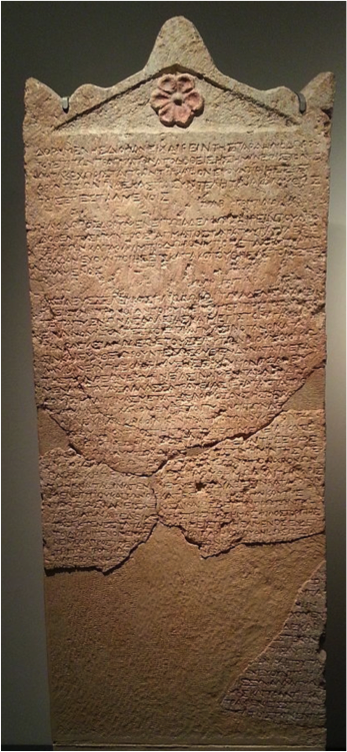
Israel Museum / Israel Antiquities Authority
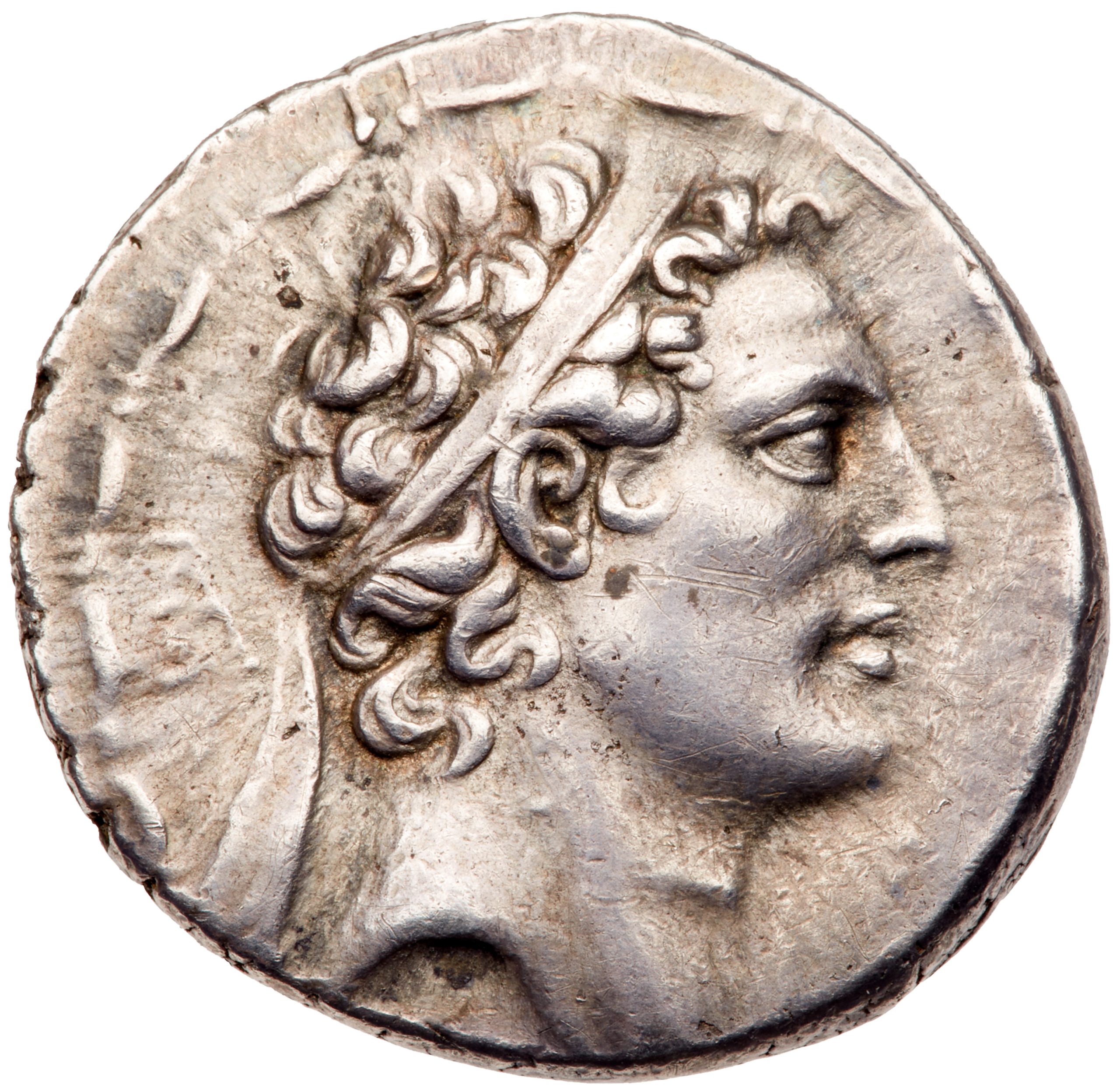
Coin of Antiochus IV, Collection of George Blumenthal
Photo by Ardon Bar-Hama
King Antiochus IV Epiphanes Defiles the Temple, 175 BCE
Antiochus IV Epiphanes (r. 175-164 BCE) became the first leader in history to engage in religious persecution. Antiochus strove to bring about a cultural uniformity, forcing upon the Jews the Hellenistic way of life and the worship of the Greek pantheon, especially Zeus. By taking the epitaph Epiphanes (“God Manifest”), Antiochus even claimed to be Zeus incarnate.
1 Maccabees 1:45-50
“He (Antiochus IV) ordered them not to offer burnt offerings, grain offerings, or wine offerings in the Temple, and commanded them to treat Sabbaths and festivals as ordinary work days . They were even ordered to defile the Temple and the holy things in it. They were commanded to build pagan altars, temples, and shrines, and to sacrifice pigs and other unclean animals there. They were forbidden to circumcise their sons…”
1 Maccabees 1:60-61
“Mothers who had allowed their babies to be circumcised were put to death in accordance with the king's decree. Their babies were hung around their necks…”
Josephus, Antiquities 12.5.4
“...the King (Antiochus IV) had built an idol altar upon God’s altar he slew swine upon it…”
With Antiochus IV taking the throne, gradual, deliberate, and
later forceful steps to Hellenize the Jews were put into place, strategically
"gutting" the essence of Jewish religious practice, leaving only a
shell of pretense that would easily accommodate Greek ideologies.
One of his first actions was to take control of the Temple by
undermining the office of the High Priest. Next was destroying the Jewish
Calendar. Jewish appointed times including the Sabbath, holy festivals, and the
sanctification of the New Moon are part of the Jewish responsibility to
sanctify time. Prohibiting the Jews from this observance would severely impede
them from practicing Judaism. The prohibition of keeping kosher and the study
of Torah followed and finally, he forbade circumcision, the physical sign of
the Jewish covenant with G-d.
1 Maccabees 1:45-50 “He (Antiochus IV) ordered them not to offer burnt offerings,
grain offerings, or wine offerings in the Temple, and commanded them to treat
Sabbaths and festivals as ordinary workdays. They were even ordered to defile
the Temple and the holy things in it. They were commanded to build pagan
altars, temples, and shrines, and to sacrifice pigs and other unclean animals
there. They were forbidden to circumcise their sons…”
1 Maccabees 1:60-61“Mothers who had allowed their babies to be circumcised were put
to death in accordance with the king's decree. Their babies were hung around
their necks…” Josephus, Antiquities 12.5.4“...the King (Antiochus IV) had built an idol altar upon God’s
altar he slew swine upon it…”
Under
the epitaph Epiphanes meaning “God Made Manifest”, Antiochus introduced
religious persecution to the world.
Antiochus IV Sold the High Priesthood in Jerusalem
Onias III Is Ousted as High Priest, 175 BCE
2 Maccabees 4:7-10
...Jason the brother of Onias (III) became High Priest by corrupt means. He went to see the king (Antiochus IV) and offered him 27,000 pounds of silver with 6,000 more pounds to be paid later... as soon as Jason took over the office of High Priest, he made the people of Jerusalem change to the Greek way of life.
Menelaus Becomes High Priest, 172 BCE
2 Maccabees 4:23-25
Three years later, Jason sent Menelaus to take some money to the king and to get his decision on several important matters. But when he stood before the king, Menelaus impressed him with his show of authority and offered 22,500 pounds of silver more than Jason had offered for his appointment to the office of High Priest. As a result Menelaus returned to Jerusalem with papers from the king, confirming him as High Priest.
Menelaus Had Onias III Murdered; Onias IV, the legitimate descendent of Zadok the High Priest, Fled to Egypt
2 Maccabees 4:31-34
"So the king left Andronicus, one of his high officials, in command, while he hurried off to Cilicia to restore order. Menelaus took advantage of this opportunity and presented Andronicus with some of the gold objects he had removed from the Temple in Jerusalem... Then Menelaus secretly persuaded Andronicus to kill Onias (III) ... Andronicus finally lured him away from the safety of the temple and immediately murdered him in cold blood."

In 175 BCE Antiochus IV Sold the High Priesthood in Jerusalem
ousting Onias III as High Priest.
2 Maccabees 4:7-10
...Jason the brother of Onias (III) became High Priest by corrupt
means. He went to see the king
(Antiochus IV) and offered him 27,000 pounds of silver with 6,000 more pounds
to be paid later...
As soon as Jason took over the office of High Priest, he made the
people of Jerusalem change to the Greek way of life. Three years later Menelaus
bought himself the position of High Priest and had Onias III Murdered. Onias
IV, the legitimate descendent of Zadok the High Priest, Fled to Egypt.
The High Priesthood wasn’t merely a technical position, but one of
great holiness. The first criterion was that it could only be given to those
from the line of Aharon, the brother of Moses. A study in 2009 by the Division
of Biotechnology at the University of Arizona in conjunction with the
Technion-Israel Institute of Technology and Rambam Medical Centre confirms that
a very specific DNA Y chromosome has been discovered proving the specific
priestly lineage. The finding reads: "The extended Cohen Modal Haplotype
accounts for almost 30 percent of Cohanim Y chromosomes from both Ashkenazi and
non-Ashkenazi Jewish communities, is virtually absent in non-Jews, and likely
traces to a common male ancestor that lived some 3,200 years ago in the Ancient
Near East."
The second criterion for the High Priest was that he had to have
an impeccable character surpassing his peers in wisdom and piety. The position
was passed on from father to son. His most important service was entering the
Holy of Holies only once a year during the Yom Kippur service and was done with
utmost reverential fear, as his life and the future of Israel depended on it.
During
the First Temple period which lasted about 410 years, only eighteen High
Priests served. The first three High
Priests of the Second Temple period held the position for 130 years. Once the
High Priesthood became corrupted by the Greeks, 300 High Priests died during
the remainder of the 420 years the Second Temple stood, most were murdered by
their successors or died during their entry into the Holy of Holies.
Many Jews became seduced by Greek culture, mostly the upper class aligning themselves with the Greek authorities and imitating their ways. Referred to as Hellenists, they sent their children to gymnasiums and reversed their circumcision through a painful procedure called epispasm. Josephus, Antiquities 12.5.1 "Menelaus, and the sons of Tobias...were desirous to leave the laws of their country and the Jewish way of living... they desired [Antiochus Epiphanes'] permission to build a Gymnasium in Jerusalem...they also hid the circumcision of their genitals; that even when they were naked, they might appear to be Greeks. Accordingly, they left off all the customs that belonged to their own country and imitated the practices of other nations." A further fracture appeared that would become a major religious schism to the end of the Second Temple Period. Two students, Zadok and Bysos championed a new form of Judaism under Grecian influence. The followers of Zadok, called the Zadukim or Sadducees rejected the idea of G-d's involvement in man's affairs and denied the immortality of man's soul with a disregard of divine reward and punishment. This stood opposed to the mainstream observant Jews who followed the Perushim, pharisees or rabbis expanding on the Torah and urged the nation to guard the distinction of the Jewish People from other nations and pagan religions. The Sadducees played a key part in the corruption of the Priesthood, acquiring the position through money and murder.
Hellenization of the Jews
Josephus, Antiquities 12.5.1
"Menelaus, and the sons of Tobias...were desirous to leave the laws of their country and the Jewish way of living... they desired [Antiochus Epiphanes'] permission to build a Gymnasium in Jerusalem...they also hid the circumcision of their genitals (epispasm); that even when they were naked they might appear to be Greeks. Accordingly they left off all the customs that belonged to their own country and imitated the practices of other nations."
Terracotta Panathenaic Prize Amphora Attributed to the Euphiletos Painter, c. 530 BCE
Metropolitan Museum of Art, New York
Onias IV Flees to Egypt and Builds a Jewish Temple at Leontopolis
Josephus, Antiquities 13.3.1-3
" But then the son of Onias (III) the High Priest, who was of the same name with his father... resolved to send to King Ptolemy (VI) and Queen Cleopatra (II), to ask leave of them that he might build a temple in Egypt, like to that at Jerusalem... And this was their reply.
"King Ptolemy and Queen Cleopatra, to Onias, send greeting. We have read thy petition; wherein thou desirest leave to be given thee to purge that (Egyptian) temple which is fallen down at Leontopolis... since thou sayest that Isaiah the Prophet foretold this long ago ; we give thee leave to do it; if it may be done according to your law; and so that we may not appear to have at all offended God herein."
So Onias took the place, and built a temple, and an altar to God..."
Onias Papyrus 63, (CPJ 132),164 BCE
"Herodes to Onias (IV) greeting. King Ptolemy (VI) is well and King Ptolemy the brother and Queen Cleopatra (II) the sister and their children, and their affairs are also as usual; if you also are in good health and all else is in order with you, it would be as we wish; we too are progressing well enough..."

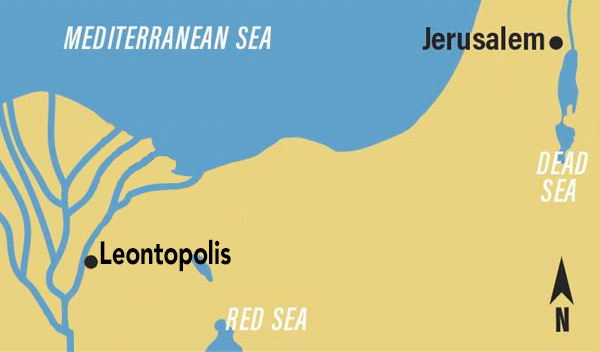
In Antiquities of the Jews 13.3.1-3 Josephus writes that Onias IV
who fled to Egypt after the murder of his father, requested from King Ptolemy
VI and Queen Cleopatra II to build a temple in Egypt modelled after the Temple
in Jerusalem. He mentioned that this was foretold by the prophet Isaiah.
Isaiah 19:19 "In that day there shall be an altar to the L-rd in the midst
of the land of Egypt"
Josephus writes that the King and Queen replied favourably: "Since
thou sayest that Isaiah the Prophet foretold this long ago; we give thee leave
to do it; if it may be done according to your law; and so that we may not
appear to have at all offended G-d herein. So Onias took the place, and built a
temple, and an altar to G-d..."
The Onias Papyrus circa 164 BCE that was discovered in the
Serapeion near Memphis in the immediate vicinity of Tell el-Yahudiya, confirms
correspondence between the parties: "Herodes to Onias (IV) greeting. King Ptolemy (VI) is well and King Ptolemy
the brother and Queen Cleopatra (II) the sister and their children, and their
affairs are also as usual;"
In
1890 the ancient temple was discovered in the City of Leontopolis or referred
to by its Egyptian Arabic name Tell el-Yahudiya which means the “Jewish Mound”.
The Hebrew colony, who lived there during the 2nd century BCE practiced their
national worship and increased even more when refugees from the oppressions of
the Seleucid kings in Judea joined. The community flourished for more than
three centuries afterward.
1887 Excavation of Tell El-Yahudiyeh at Leontopolis, Photo by Rev. W. MacGregor
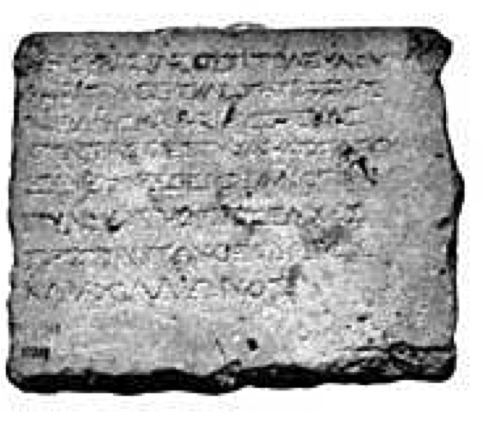
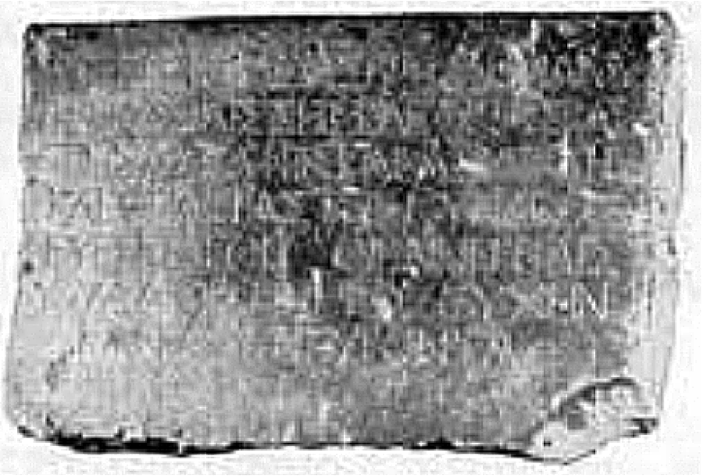
Alexandria Museum
Two Jewish Synagogues in Egypt, c. 140-116 BCE
From the Greek word meaning “prayer,” a proseuche is a synagogue or a place for Jews to pray. Several proseuche dedication inscriptions from Ancient Egypt have been discovered, including these, dating from c. 140-116 BCE.
Proseuche Dedication from Xenephyris
“On behalf of king Ptolemy (VIII) and queen Cleopatra (II) the sister and queen Cleopatra (III) the wife , the Jews of Xenephyris (dedicated) the gateway of the proseuche when Theodore and Achillion were presiding.”
Proseuche Dedication from Nitriai
“On behalf of a king Ptolemy (VIII) and queen Cleopatra (II) the sister and queen Cleopatra (III) the wife, Benefactors, the Jews in Nitriai (dedicated) the proseuche and its appurtenances.”
More proseuche or synagogue dedication inscriptions from Ancient
Egypt have been discovered, dating between 140 - 116 BCE that of Xenephyris and
Nitriai.
Proseuche Dedication from Xenephyris
“On behalf of King Ptolemy (VIII) and Queen Cleopatra (II) the
sister and queen Cleopatra (III) the wife, the Jews of Xenephyris (dedicated)
the gateway of the proseuche when Theodore and Achillion were presiding.”
Proseuche Dedication from Nitriai
“On
behalf of King Ptolemy (VIII) and Queen Cleopatra (II) the sister and queen
Cleopatra (III) the wife, Benefactors, the Jews in Nitriai (dedicated) the
proseuche and its appurtenances.”

Center for the Tebtunis Papyri, Bancroft Library
University of California, Berkeley
Record of Jews in the Egyptian Army of Ptolemy VIII
The Tebtunis Papyri is an archive discovered in Tebtunis, Egypt. Papyrus 1075, c. 2nd Century BCE, is a document listing names of people with their origins, either Jew or Macedonian, most likely a listing of a military unit.
Tebtunis Papyrus 1075
“…son of Hippodamus, a Jew,
…son of Straton, a Macedonian,
…son of Ptolemaios, a Macedonian,
...son of Sabbathaios, a Jew,
Dorion son of Dorion, a Macedonian,
Sarapion son of Demetrios, a Macedonian,
Dositheos son of Artemidoros, a Jew”
The Tebtunis Papyri is an archive discovered in Tebtunis, Egypt.
The Papyrus number 1075, circa 2nd Century BCE, is a document listing names of
people along with their origins, citing either Jew or Macedonian and was most
likely a listing of a military unit in the Egyptian Army of King Ptolemy VIII.
Tebtunis Papyrus 1075
“…son of Hippodamus, a Jew
,
…son of Straton, a Macedonian,
…son of Ptolemaios,
a Macedonian
,
...son of Sabbathaios, a Jew,
Dorion son of Dorion, a Macedonian
,
Sarapion son of Demetrios, a Macedonian
,
Dositheos
son of Artemidoros, a Jew”
The Acra Citadel, 168 BCE
In 168 BCE, the Seleucids built a fortress, "the Acra," overlooking the Temple Mount. In 2015, its ruins were discovered in the City of David, Jerusalem.
Josephus, Antiquities 12.5.4
“... the King (Antiochus IV) came up to Jerusalem… And he burnt the finest parts of the city and, pulling down the walls, built the Acra in the Lower City; for it was high enough to overlook the Temple, and it was for this reason that he fortified it with high walls and towers, and stationed a Macedonian garrison therein.“
1 Maccabees 1:33-35
"They (the Seleucid forces) then rebuilt the City of David with a great strong wall and strong towers and made this their Citadel ( Greek: Acra). There they installed a brood of sinners, of renegades, who fortified themselves inside it, storing arms and provisions, and depositing there the loot they had collected from Jerusalem..."
In 168 BCE, Antiochus IV built a fortress called "the Acra," in order to control Jerusalem and monitor activity in the Temple. Acra in Greek refers to a reinforced citadel. Josephus, Antiquities 12.5.4“... the King (Antiochus IV) came up to Jerusalem… And he burnt the finest parts of the city and, pulling down the walls, built the Acra in the Lower City; for it was high enough to overlook the Temple, and it was for this reason that he fortified it with high walls and towers, and stationed a Macedonian garrison therein. “ Various writings describe the Acra as a thorn in the flesh of the Jewish inhabitants of the City of David, as Jews who joined the wicked ruler as Hellenists, mocked their fellow "narrow-minded" Jews for "suffering" from their outdated religious traditions. 1 Maccabees 1:33-35"They (the Seleucid forces) then rebuilt the City of David with a great strong wall and strong towers and made this their Citadel. There they installed a brood of sinners, of renegades, who fortified themselves inside it, storing arms and provisions, and depositing there the loot they had collected from Jerusalem..." In 2015, its ruins were discovered in the City of David, the location of Ancient Jerusalem, placing the Acra south of the Temple Mount, in the center of the City of David, spreading its colossal self over the width of the whole southern hill. Its location severed the Temple Mount from the rest of the city. The excavation produced bronze arrowheads and ballista stones, numerous coins, ranging in date from the reign of Antiochus IV to that of Antiochus VII testifying to the citadel’s chronology.
Photo by Asaf Peretz, Israel Antiquities Authority
The Revolt of the Maccabees against the Seleucids, 167 BCE
In 167 BCE, the soldiers of Antiochus IV entered the city of Modin (13 miles northwest of Jerusalem) and ordered Mattathias, a priest, to slay a pig on a pagan altar. Mattathias refused, overturning the altar and slaying the king’s general.
This began the 35 year long Maccabean revolt of Mattathias and his five sons, Judas Maccabeus (Judah Maccabee), Eleazar Avaran, Simon Thassi, John Gaddi and Jonathan Apphus.
Josephus, Antiquities 12.6.2
“But when those that were appointed by the King (Antiochus IV) were come to Modin, that they might compel the Jews to do what they were commanded… Mattathias (father of Judah Maccabee) said... not he nor his sons would leave the religious worship of their country.”
1 Maccabees 2:27
And Mattathias cried throughout the city with a loud voice, saying, Whosoever is zealous of the law, and maintaineth the covenant, let him follow me.
The religious oppression under the Greeks took a turn in 167 BCE, when the soldiers of Antiochus IV entered the city of Modi'in, 13 miles northwest of Jerusalem, and ordered Mattathias , a priest, to slay a pig on a pagan altar. Mattathias refused, overturning the altar and slaying the king’s general.
This began the 35-year-long Maccabean revolt of Mattathias and his five sons, Judah the Maccabee, Eleazar Avaran, Simon Thassi, John Gaddi, and Jonathan Apphus.
Mattathias’ son Judah’s nickname was Maccabee which means “the Hammer”. Some believe it referred to his ferocity in battle, others say the hammer was his weapon of choice. Maccabee is also the Jewish acronym for "Mi Kamocha Be'eilim Hashem" meaning "Who is like you among the powers, O G-d" which was used as a battle cry amongst the army ranks.
Josephus, Antiquities 12.6.2
“But when those that were appointed by the King (Antiochus IV) were come to Modin, that they might compel the Jews to do what they were commanded… But Mattathias said, “He would not do it: and that if all the other nations would obey the commands of Antiochus, either out of fear, or to please him; yet would not he nor his sons leave the religious worship of their country.”
1 Maccabees 2:27
And Mattathias cried throughout the city with a loud voice, saying, whosoever is zealous of the law, and maintains the covenant, let him follow me!
In this picture is the ancient site of the Tomb of the Maccabees, in Modi'in, Israel.
Tomb of the Maccabees, Modi'in, Israel
Israel Antiquities Authority
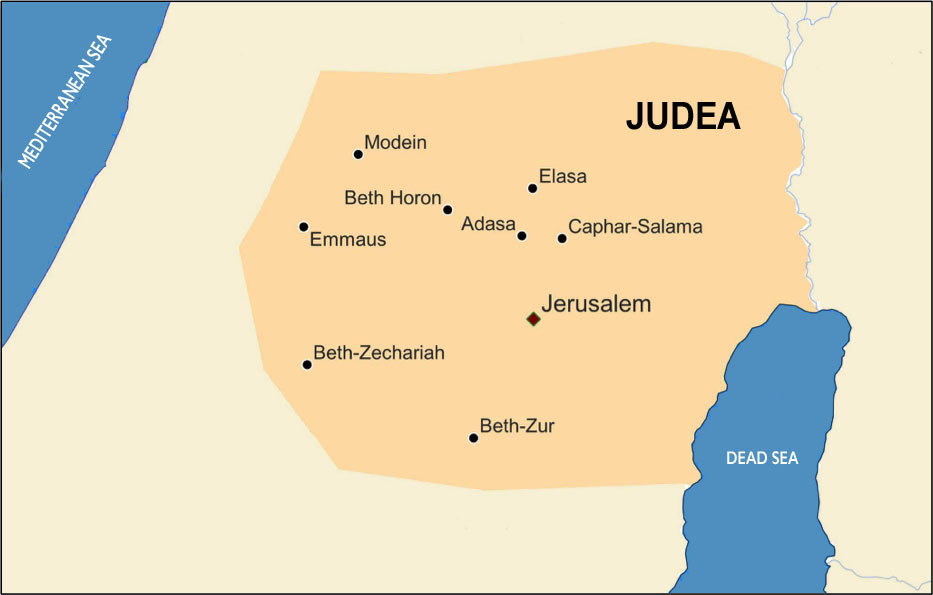
The Maccabean army was vastly outnumbered by the Greeks in number, equipment, and skill. At first, the Maccabean forces employed guerrilla tactics in the Judean countryside, but over the span of 30 years, the movement developed into a proper army capable of attacking the fortified Seleucid cities. The majority of the battles took place in the foothills leading up to Jerusalem.
Key Battles include:
166 BCE - Battle of Beth Horon
165 BCE - Battle of Emmaus
164 BCE - Battle of Beth Zur
164 BCE – Battle of Temple Mount and the rededication of the Temple, still celebrated today as Hanukkah.
162 BCE - Battle of Beth Zechariah; Eleazar Avaran dies in battle
161 BCE - Battle of Adasa
160 BCE - Battle of Elasa; Judah Maccabee dies in battle
160 BCE - John Gaddi is killed by the sons of Jambri from Medeba
142 BCE - Jonathan Apphus was executed by Diodotus Tryphon at Baskama, east of the Jordan
Mattathias died in battle somewhere in 166 BCE.
Major Battles of the Maccabean Revolt in Judea,
167 to 132 BCE
- 166 BCE - Battle of Beth Horon
- 165 BCE - Battle of Emmaus
- 164 BCE - Battle of Beth Zur
- 164 BCE - Battle of Temple Mount, Jerusalem (Hanukkah Event)
- 162 BCE - Battle of Beth Zechariah; Eleazar Avaran dies
- 161 BCE - Battle of Adasa
- 160 BCE - Battle of Elasa; Judah Maccabee dies
- 160 BCE - John Gaddi is killed by the sons of Jambri from Medeba
- 142 BCE - Jonathan Apphus was executed by Diodotus Tryphon at Baskama, east of the Jordan
Judah Maccabee Purifies the Temple, 164 BCE
In 166 BCE, Mattathias died in battle. His eldest son, Judas, “The Hammer,” (Judah Maccabee) purified and rededicated the Temple, establishing the Festival of Hanukkah on the 25th Day of Kislev, 164 BCE. The word “Hanukkah” derives from the Hebrew word meaning “to dedicate.”
Josephus, Antiquities 12.7.6-7
“...Judah Maccabee assembled the people and told them that after the many victories which God had given them they ought to go up to Jerusalem and purify the Temple and offer the appointed sacrifices.
And so Judah and his fellow citizens celebrated the festival of the restoration of the sacrifices of the Temple for eight days, …they made it a law for their posterity, that they should keep a festival on account of the restoration of their Temple worship for eight days. And from that time to this we celebrate this festival, and call it Lights."
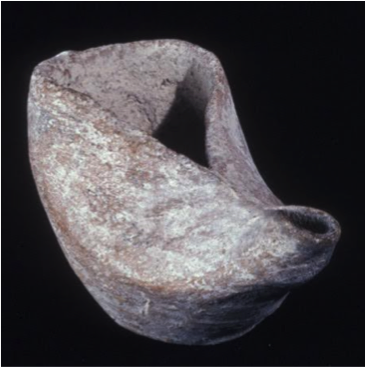
Hasmonean Oil Lamp from the Time of the Maccabees,
Collection of George Blumenthal
Photo by Ardon Bar-Hama
After three years of battle, the Jews were able to retake Jerusalem,
except for the Acra fortification. Reaching Temple Mount, they found the Temple
disgraced and converted into a pagan sanctuary, riddled with idols, and the
altar defiled with pig's blood.
Judah purified and rededicated the Temple on the 25th of Kislev,
164 BCE, and established the Festival of Hanukkah, the Hebrew word meaning
"dedication".
Josephus, Antiquities 12.7.6-7“ And so Judah and his fellow citizens celebrated the festival of
the restoration of the sacrifices of the Temple for eight days, …they made it a
law for their posterity, that they should keep a festival on account of the
restoration of their Temple worship for eight days. And from that time to this
we celebrate this festival, and call it Lights."
As referred to by Josephus the festival of Hanukkah is celebrated
for eight days.
The Talmud (Shabbat 21b) sheds light on the reason: "And when the royal Hasmonean House gained the upper hand and
vanquished [the Greeks], they searched and found only one flask of oil.... with
the High Priest's seal, and it contained only oil to burn for one day. A
miracle occurred and it burned for eight days.
The
priests used the vial with pure oil to light the candles of the menorah.
Jewish Holidays During the Time of the Maccabees
2 Maccabees 1:9, 100 BCE
“And now see that you keep the feast of the booths (i.e. Sukkot). ..”
The Day of Nikanor
The Day of Nikanor marks the day when Judah the Maccabee killed Nikanor, the Greek tyrant who brutally oppressed the Jews.
2 Maccabees 15:36, 100 BCE
“By unanimous vote it was decided that this day would never be forgotten, but would be celebrated each year on the eve of Mordecai's Day, which is the thirteenth day of the twelfth month, called Adar in Aramaic .”
The 13th of Adar which was called Mordechai's Day or in modern times the Fast of Esther, confirming that the Jews were still celebrating the Purim festivities as decreed 300 years earlier in Persia by Mordechai and Queen Esther. The Festival of Purim is still celebrated today.
As we've learned, the Jewish observance of sanctifying time that stands central in the Jewish faith was abolished under Greek rule. In the aftermath of the rededication of the Temple, the Jewish People were encouraged to keep the Holy Festivals again as seen in 2 Maccabees 1:9: “And now see that you keep the feast of the booths (i.e. Sukkot)...” The Day of Nikanor, another commemoration, marks the day when Judah the Maccabee killed Nikanor, the Greek tyrant who brutally oppressed the Jews. The Second Book of Maccabees notes that it falls on the 13th of Adar which was called Mordechai's Day or in modern times the Fast of Esther, confirming that the Jews were still celebrating the Purim festivities as decreed 300 years earlier in Persia by Mordechai and Queen Esther. The Festival of Purim is still celebrated today. 2 Maccabees 15:36, 100 BCE“By unanimous vote, it was decided that this day would never be forgotten, but would be celebrated each year on the eve of Mordecai's Day, which is the thirteenth day of the twelfth month, called Adar in Aramaic.”
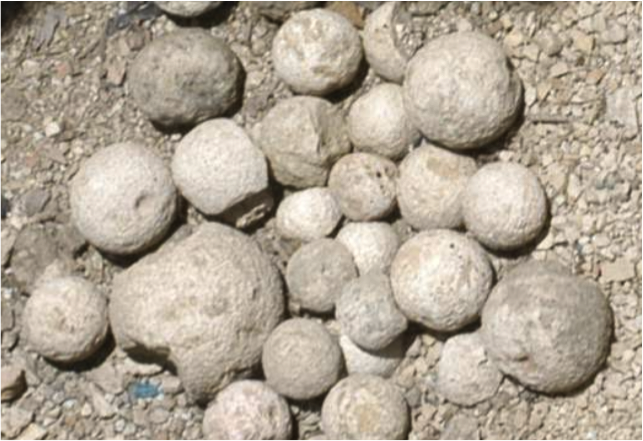
After the victory and restoration of the Temple, Judah undertook wars throughout the Land of Israel to eradicate paganism from the country and eliminate Hellenizing rivals. Judah was killed in the battle of Elasa against the Seleucids in 160 BCE. The Hasmonaeans now rallied around Jonathan, his brother. Jonathan turned his focus towards fortifying Jerusalem and cutting off the Greek garrison fortifying themselves in the Acra. Josephus, Antiquities 13.5.11“Jonathan gathered all the people together in the Temple and advised them to repair the walls of Jerusalem, … and, in addition, to build still another wall in the midst of the city to keep the garrison in the citadel (Acra) from reaching the city, and in this way cut off [the garrison’s] large supply of provisions.” Pictured here are Hasmonean Sling Stones, Seleucid arrowheads, and sling bullets. The word "victory" is inscribed on one side of the sling bullet.
Hasmonean Sling Stones
Tower of David Museum, Jerusalem, Photo by Ardon Bar-Hama

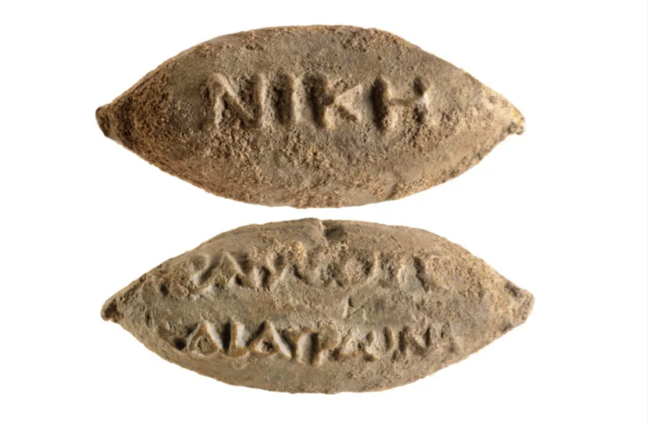
Seleucid arrowhead and sling bullets. The word "victory" is inscribed on one side of the sling bullet. Israel Antiquities Authority
Jonathan Fortifies Jerusalem, 144 BCE
Josephus, Antiquities 13.5.11
“Jonathan gathered all the people together in the Temple and advised them to repair the walls of Jerusalem, … and, in addition, to build still another wall in the midst of the city to keep the garrison in the citadel (Acra) from reaching the city, and in this way cut off [the garrison’s] large supply of provisions.”
The Seleucids Withdraw, 137-132 BCE
1 Maccabees 14:36
“And in his (Simon’s) time everything prospered in his hands, so that the heathen were expelled from their country, as well as those in the city of David, in Jerusalem, who had made a citadel for themselves…”
Four of the five brothers fell in battle. Simon, the last brother of the priestly family took up the position of High Priest and continued the battles against Greece. King Demetrius II and Simon finally agreed to a peace treaty in the year 141 BCE. But the Acra still stood, defiantly eclipsing Temple Mount. Simon finally got the upper hand over the wicked stronghold after a long besiegement. It took him another three years to raze the Acra to the ground. The Seleucids finally withdrew sometime between 137-132 BCE. 1 Maccabees 14:36 “And in his (Simon’s) time, everything prospered in his hands, so that the heathen were expelled from their country, as well as those in the city of David, in Jerusalem, who had made a citadel for themselves…”
Drawing by Shalom Kweller, the City of David
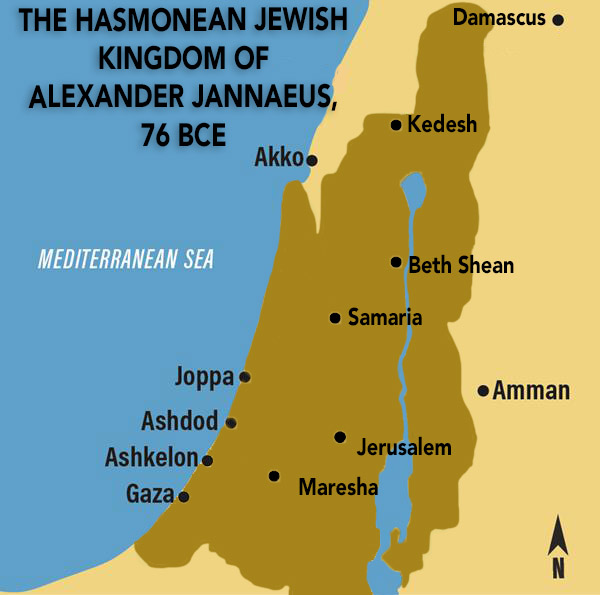
Hasmonean Kingdom
The family name of the Hasmonean dynasty originates with the ancestor of the house, whom Josephus Flavius called by the Hellenised form Asamoneus.
Hasmonean Monarchs
Simon Thassi (brother of Judah Maccabee),142-134 BCE
John Hyrcanus I, 134-104 BCE - supported Sadducees
Aristobulus I, 104-103 BCE - supported Sadducees
Alexander Jannaeus, 103-76 BCE - supported Sadducees
Salome Alexandra, 76-67 BCE - supported Pharisees
Hyrcanus II, 67-66 BCE - supported Pharisees
Aristobulus II, 66-63 BCE - supported Sadducees
Mattathias Antigonus, 40-37 BCE - both Pharisees and Sadducees
The Maccabean family is also known as the Hasmoneans.
The family name of the Hasmonean dynasty originates from the ancestor of the house, Hasmon, said to have been the great-grandfather of Mattathias whom Josephus called by the Hellenised form Asamoneus.
With the position of High Priest, Simon, the last of the Maccabees, also took on the title of "Nasi" or prince. Though he didn't refer to himself as King, this delicate distinction wasn't honored by his descendants, who later declared themselves kings.
According to the Torah, priests who come from the Tribe of Levi and specifically the line of Aharon, are not allowed to take up the position of King or vice versa, as Jewish kingship is exclusively dedicated to the line of King David from the tribe of Judah. This mixture of inter-tribal leadership positions became the root of terrible corruption in the Hasmonean family, ultimately leading to their downfall and bringing the Jewish People to ruin.
It also caused most of the later Hasmonean kings to side with the Sadducees, who, corrupted by money and power, shunned most of the Jewish Law to remain in favor with their Grecian and later Roman overlords.
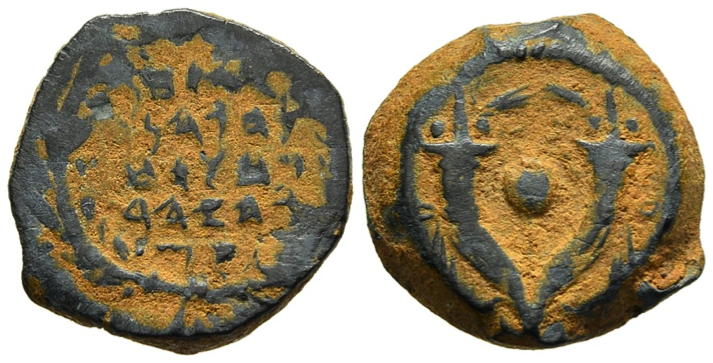
Coin of John Hyrcanus I, r. 134-104 BCE
Inscribed in Paleo Hebrew: “Yehonanan the High Priest and the Council of the Jews”
Forum Ancient Coins
John Hyrcanus Becomes High Priest, 134 BCE
Josephus, Antiquities 13.10.7
“But when Hyrcanus had put an end to this sedition, he after that lived happily, and administered the government in the best manner for thirty one years... He was esteemed by G-d worthy of three of the greatest privileges, the government of his nation, the dignity of the High Priesthood, and prophecy; for G-d was with him..."
In this picture is a coin of John Hyrcanus I, who took over the Priesthood and leadership from his father, Simon, and ruled from 134-104 BCE. The coin is inscribed in Paleo Hebrew and reads “Yehochanan the High Priest and the Council of the Jews”.
Josephus, Antiquities 13.10.7
“But when Hyrcanus had put an end to this sedition, he after that lived happily, and administered the government in the best manner for thirty-one years... He was esteemed by G-d worthy of three of the greatest privileges, the government of his nation, the dignity of the High Priesthood, and prophecy; for G-d was with him..."
Hyrcanus greatly expanded the borders of Israel to strengthen the country but went against Jewish law and started to forcefully convert the people he conquered. Judaism discourages any kind of conversion, especially under duress. The Idumeans who were the descendants of the ancient Edomites, were also forced to convert. A descendant of one of the Idumean families would later be appointed by Rome as a Jewish King – his name, Herod .
Aristobulus I (Yehuda), son of John Hyrcanus, Claims both the Kingship and the High Priesthood, r. 104-103 BCE
Josephus, Antiquities 13.11.1
“Now when their father Hyrcanus (I) was dead, the eldest son, Aristobulus, intending to change the government into a Kingdom; for so he resolved to do; first of all put a diadem on his head, four hundred eighty and one years and three months…
He also cast his mother into prison; because she disputed the government with him. ... He also proceeded to that degree of barbarity, as to kill her in prison with hunger. Nay he was alienated from his brother Antigonus by calumnies, and added him to the rest whom he slew…”
Yehudah Aristobulus I, son of John Hyrcanus and grandson of Simon,
not only claimed the High Priesthood but declared himself king. He reigned from
104-103 BCE.
Josephus, Antiquities 13.11.1
“Now when their father Hyrcanus (I) was dead, the eldest son,
Aristobulus, intending to change the government into a Kingdom; for so he
resolved to do; first of all put a diadem on his head, four hundred eighty and
one years and three months…
In
this picture is the coin of Aristobulus I inscribed in Paleo Hebrew:
"Yehuda the High Priest and the Council of the Jews"

Coin of Aristobulus I, r. 104-103 BCE
Inscribed in Paleo Hebrew: "Yehuda the High Priest and the Council of the Jews"
David Hendin, Guide to Biblical Coins, Photo: Goldberg Coins & Collectibles
created with
WordPress Website Builder .